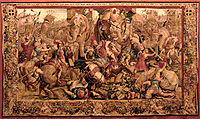- Gobelins Manufactory
-
For other uses, see Gobelins (disambiguation).
The Manufacture des Gobelins is a tapestry factory located in Paris, France, at 42 avenue des Gobelins, near the Les Gobelins métro station in the XIIIe arrondissement. It is best known as a royal factory supplying the court of Louis XIV and later monarchs; it is now run by the French Ministry of Culture, and open for guided tours several afternoons per week by appointment.
Contents
Royal factory
 Rear view of the Gobelin Manufactory, adjoining the Bièvre river, in 1830.
Rear view of the Gobelin Manufactory, adjoining the Bièvre river, in 1830.
The Gobelins were a family of dyers, who in the middle of the 15th century established themselves in the Faubourg Saint-Marcel, Paris, on the banks of the Bièvre.
In 1602, Henry IV of France rented factory space for his Flemish tapestry makers on the current location of the Gobelins Manufactory adjoining the Bièvre river.
In 1662 the works in the Faubourg Saint Marcel, with the adjoining grounds, were purchased by Jean-Baptiste Colbert on behalf of Louis XIV and made into a general upholstery factory, in which designs both in tapestry and in all kinds of furniture were executed under the superintendence of the royal painter, Charles Le Brun, who served as director and chief designer from 1663-1690. On account of Louis XIV's financial problems, the establishment was closed in 1694, but reopened in 1697 for the manufacture of tapestry, chiefly for royal use. It rivalled the Beauvais tapestry works until the French Revolution, when work at the factory was suspended.
The Bourbons revived the factory during the Restauration, and in 1826 the manufacture of carpets was added to that of tapestry. In 1871 the building was partly burned down by the Communards. The factory is still in operation as a state-run institution.
Historical site
Today the manufactory consists of a set of four irregular buildings dating to the seventeenth century, plus the building on the avenue des Gobelins built by Jean-Camille Formigé in 1912 after the 1871 fire. They contain Le Brun's residence and workshops that served as foundries for most of the bronze statues in the park of Versailles, as well as looms on which tapestries are woven following seventeenth century techniques.
-
Battle of Zama, Gobelin tapestry after Jules Romain, manufactured for Louis XIV in 1688-1690. Louvre Museum.
-
Gobelins tapestry, circa 1680, in the Musée Nissim de Camondo, Paris.
-
La sortie de l'Ambassadeur Turc du Jardin des Tuileries (Ottoman Empire embassy of Mehemet Effendi), Atelier Lefebvre et Mommerqué, Gobelins, 1734-1737.
-
Louis XIV visits the Gobelins with Colbert, 15 October 1667. Tapestry from the series, "Histoire du roi" designed by Charles Le Brun and woven between 1667 and 1672.
See also
References
- Manufacture nationale des Gobelins
- Lacordaire, Notice historique sur les Manufactures impériales de tapisseries des Gobelins et de tapis de la Savonnerie, précédée du catalogue des tapisseries qui y sont exposées (Paris, 1853)
- Genspach, Répertoire détaillé des tapisseries exécutées aux Gobelins, 1662–1892 (Paris, 1893)
- Jules Guiffrey, Histoire de la tapisserie en France (Paris, 1878–1885).
- Museums of Paris entry
- Paris.org entry
Note that Genspach and Guiffrey were directors of the factory.
Coordinates: 48°50′05″N 02°21′10″E / 48.83472°N 2.35278°E
 This article incorporates text from a publication now in the public domain: Chisholm, Hugh, ed (1911). Encyclopædia Britannica (11th ed.). Cambridge University Press.
This article incorporates text from a publication now in the public domain: Chisholm, Hugh, ed (1911). Encyclopædia Britannica (11th ed.). Cambridge University Press.Tapestry Tapestries Adoration of the Magi · Bayeux Tapestry · Devonshire Hunting Tapestries · Hestia Tapestry · Holy Grail tapestries · Hunt of the Unicorn · Jagiellonian tapestries · Lady and the Unicorn · New World Tapestry · Överhogdal tapestries · Pastoral Amusements · Quaker Tapestry · Raphael Cartoons · Ros Tapestry Project · Sampul tapestry · Scottish Royal tapestry collection · Valois TapestriesStyles Studios Aubusson · Beauvais · Gobelins · Moravská Gobelínová Manufaktura · Mortlake · Morris & Co. · Portalegre · William Baumgarten & CoWeavers and designers Related Categories:- Art museums and galleries in Paris
- History of Paris
- Manufacturing companies of France
- Tapestries
-
Wikimedia Foundation. 2010.








